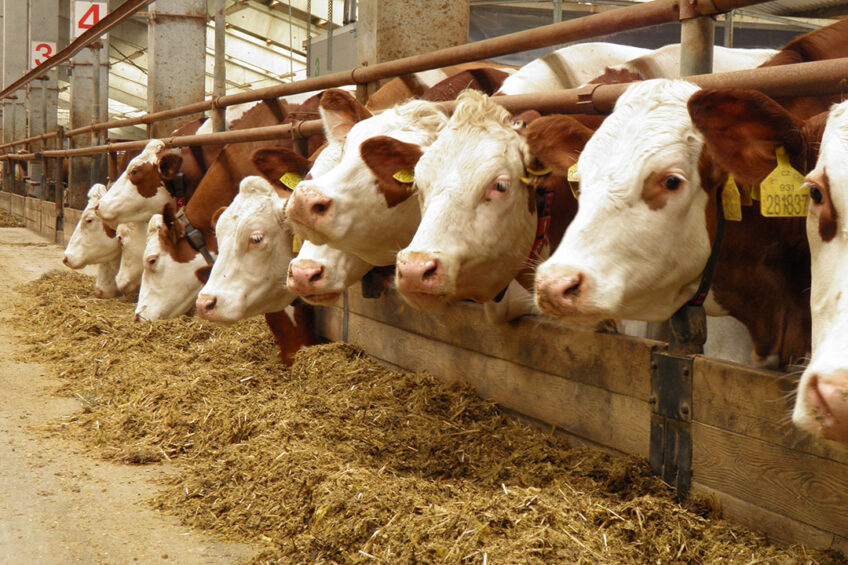Heat stress releases harmful endotoxins

Endotoxins or lipopolysaccharides can make a profit-destroying temperature problem considerably worse.
Modern dairy breeds like the Holstein Friesian breed are developed in northern countries, meaning they are tolerant towards cold weather conditions but susceptible to heat. In many areas around the world, summers are hot and long. This can lead to heat stress, which occurs when an animal’s heat load is greater than its capacity to lose heat. Each year over US$ 1 billion are lost due to heat stress in cattle in the United States alone. Annual losses in dairy and beef are estimated to be $ 897 million and $ 369 million, respectively. These monetary losses represent reduced milk yield and growth, impaired reproduction, higher treatment costs and increased culling rates. A recent study from the research group at Iowa State University showed that the in vivo administration of endotoxins drastically decreased the milk yield in Holstein cows by 80%. Heat stress compromises gut integrity and allows toxic compounds such as endotoxins to enter a cow’s circulatory system and trigger an inflammatory cascade. Unwanted inflammation exacts additional costs on a cow’s performance and welfare.

Heat stress ranges
Dairy cows are more susceptible to heat stress than other livestock species due to their high metabolic heat production and their low surface area to mass ratio. Cows can already be affected by temperatures above 23°C based on the Equivalent Temperature Index for Cattle (Table 1). Heat stress can have direct or indirect effects on normal physiology, metabolism, hormonal status, and immune system in cattle. For example, respiratory rate, body temperature, sweating rate as well as feed and water intake can be altered by heat stress conditions. The physiological response to heat stress can have short-term as well as long-term effects on health and productivity in cattle. Heat stress can result in impaired rumen and gut permeability, decreased feed intake, reduced growth, decreased milk yield and affected reproduction (e.g. conception rate, embryonic growth and development).
Effect on gastrointestinal tract
One of the major organs affected by heat stress is the gastrointestinal tract. Several studies in pigs showed that the gut barrier is impaired due to heat stress. In ruminants, there are no studies describing the direct effect on the barrier function so far. In general, the effects on barrier function can partly be explained by the reduced feed intake during heat stress, but also due to the effect of different proteins (e.g. heat shock proteins) or inflammation mediators (e.g. cytokines) on the tissue itself. The rumen epithelium is essential for several physiological functions, including nutrient absorption and transport, short-chain fatty acid metabolism and barrier protection. However, the gut barrier has to be considered as well (Figure 1). The disruption of the rumen and gut barrier can lead to the translocation of toxins (e.g. endotoxins, mycotoxins) as well as unwanted metabolites (e.g. biogenic amines such as histamine) into the blood circulation.
Figure 1 – Overview about the rumen as well as intestinal epithelium. The rumen epithelial consist of four different cell layers, while the intestinal epithelium has only one cell layer. Adapted from Steele et al. (2016).

Endotoxins explained
Endotoxins, also known as lipopolysaccharides (LPS), are part of the outer membrane of the cell wall of Gram-negative bacteria (Figure 2). The lipid A part is the toxic part of LPS. Endotoxins are released during lysis of bacteria. Since an animal’s microbiota contain Gram-negative bacteria, endotoxins are always present in the rumen and gut to a certain extent.
Figure 2 – Overview of the structure of LPS: Polysaccharide (O-Antigen and Core oligosaccharide) and the toxic lipid A part.

SARA, heat stress and LPS
However, several situations e.g. sub-acute rumen acidosis (SARA), can lead to a massive increase of the endotoxins concentration in the rumen as well as gut. In healthy animals the rumen and gut barrier prevents endotoxins to enter the circulation. However, if this barrier is impaired due to heat stress, endotoxins reach the circulation and cause a strong inflammatory response. This response includes the production of cytokines and acute phase proteins e.g. haptoglobin, LPS-binding protein. This acute phase response consumes a lot of energy, which the animal cannot use anymore for growth or milk production.
Heat stress management tips What can be done to prevent the effect of heat stress? We have listed a few practical ones here: • Provide shade at lying area, water and feed bunk. • Allow slow air circulation (3-4 m/s) through side walls openings or by using fans. • Stimulate frequency of visits to the feed bank by installing nearby sprinklers. • Provide sufficient amount of good quality water (9 cm linear space per cow or 1 drinking space per 10 cows). A mature Holstein cow under heat stress may consume over 120 litres of water per day. • Offer high quality forages with good digestibility and adequate chopping length. Fibre is essential, but its metabolism produce more heat. • Glucose precursors should be preferred as source of energy or concentrate carbohydrates as glucose utilisation increases significantly in ruminants during heat stress. However, high consideration regarding the risk of acidosis should be taken. • Use feed additives that support animals during heat stress. |
Conclusion
The key to maintaining animal health and performance in periods of heat stress is to support the rumen and gut barrier function and ensure proper liver function. Producers should consider feed additives that support intestinal barrier function, neutralise endotoxins in the intestine, improve digestibility and promote feed intake. Finding the right solution may require a combination of additives tailored to a farm’s specific requirements.
Join 13,000+ subscribers
Subscribe to our newsletter to stay updated about all the need-to-know content in the dairy sector, two times a week.










